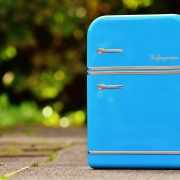Why Is My Refrigerator Making Noise?
You don’t need an expert in San Francisco appliance repair to tell you that the noises that a refrigerator makes during normal operation usually become so familiar to people in the home that eventually, they blend into the background sounds of everyday life at home. However, any variation in those noises are often noticed right away, and can be a little bit alarming.
Whether it’s making a loud vibrating sound when it runs or a drain pan is knocking loose at the bottom, you’ll want to find out what’s causing the strange noise right away. It could be something that isn’t much of a big deal to address, but you don’t want to take the chance that waiting could cause a much bigger – and more expensive – problem. Here are some reasons why a quiet refrigerator starts making noise:
Normal sounds often include things like squeaking, grinding, thumping, vibrating, or rattling. For example, the light thumping is usually heard when the water line is being filled. The squeaking or grinding can be when the doors of the refrigerator rub against an enclosure or cabinet as they are opened and closed. Vibrating or rattling occurs when refrigerant flows through the cooling system or when water runs through the lines.
If these sounds become more consistent or louder, it may signal a problem. A loose drain pan can cause an unfamiliar vibrating noise. Usually secured underneath a refrigerator, it’s meant to collect condensation from the defrost system. If the pan comes loose, you might hear it vibrate when the fridge is running. Just tightening the connecting hardware on the pan should quiet that sound. If you’re not sure how to access your pan, refer to your user manual or contact us for help.
Another noise you might hear is a squealing noise as your refrigerator runs. This could be because of a motor issue in either the condenser fans or the evaporator. These fans cool refrigerant as it flows through your appliance. Which fan is the culprit? It depends on where the sound is coming from. If the sound is louder when the refrigerator door is open, it’s the evaporator fan. If the noise is coming from behind or below the appliance, it’s the condenser fan. Contact our experts in Marin County appliance repair to remedy fan issues.
Knocking noises that aren’t normal are often caused by water inlet valve problems. Over time, a valve’s interior commonly becomes restricted by sediment and residue, limiting water flow and ice production. In addition, when this happens, the electrical controls can malfunction, causing the knocking sound. A faulty water inlet valve is not something that can be repaired – it must be replaced by a Mill Valley appliance repair expert.
Finally, if your refrigerator is humming more loudly than usual, a faulty compressor may be to blame. Compressors must be addressed by a professional, so contact Absolute Appliances Repair for assistance. We service all major brands of refrigerators and freezers, and help customers in the San Francisco area throughout Marin County, Larkspur, Mill Valley, San Rafael, and Novato.









